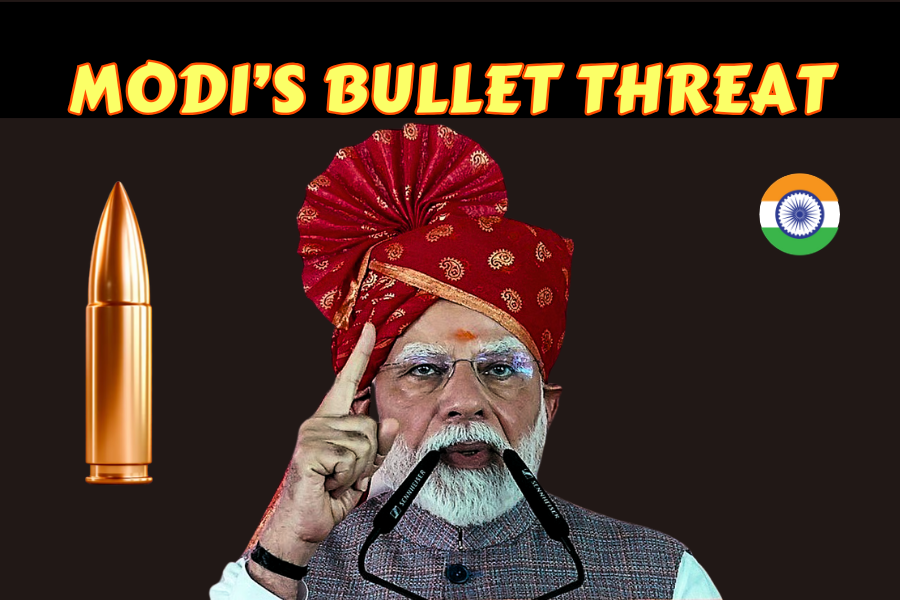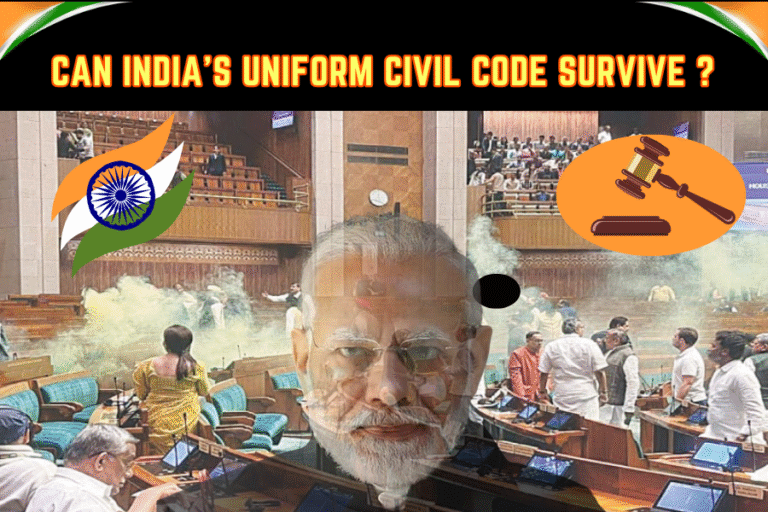(By Khalid Masood)
Introduction: A Provocative Rhetorical Escalation
In a charged election rally a few days back, Indian Prime Minister Narendra Modi declared to the people of Pakistan, “I have a bullet for you!” This statement, delivered amidst heightened tensions following the April 22, 2025, Pahalgam attack and India’s Operation Sindoor, marks a significant departure from diplomatic norms (Al Jazeera, May 12, 2025). As the leader of a nuclear-armed nation of 1.4 billion, Modi’s rhetoric raises critical questions about responsible statecraft, the ethics of leadership language, and its impact on South Asian stability. This article evaluates the implications of Modi’s statement, critiques its appropriateness for a sitting prime minister, and explores how Pakistan should respond, drawing on principles of diplomacy, English language analysis, and regional geopolitics.
1. Contextualizing the Rhetoric: A Rally Amidst Conflict
Modi’s statement emerged during India’s 2025 election campaign, following the Pahalgam attack that killed 26 tourists, which India attributed to Pakistan-based militants (CNN, May 7, 2025). Operation Sindoor, India’s May 7 airstrikes on nine sites in Pakistan and Azad Kashmir, escalated tensions, culminating in a fierce air battle where Pakistan downed six Indian jets (Reuters, May 9, 2025). Speaking at a rally in Bihar, Modi vowed to “retaliate on our own terms” against future attacks, dismissing Pakistan’s “nuclear blackmail” (Al Jazeera, May 12, 2025). The “bullet” remark, aimed directly at Pakistan’s populace, was a populist flourish, leveraging Hindi’s emotive cadence to rally domestic support (The Guardian, May 12, 2025). Posts on X, such as @JalilJilani’s, condemned it as “deeply irresponsible and dangerously inflammatory” (X, May 27, 2025).
2. Linguistic Analysis: The Power and Peril of Modi’s Words
From an English language perspective, Modi’s phrase is a stark example of belligerent hyperbole, employing a metaphor of violence (“bullet”) to assert dominance. Its direct address—“for you”—personalizes the threat, shifting from state-to-state rhetoric to targeting Pakistan’s 240 million citizens. This breaches diplomatic language conventions, which prioritize ambiguity and restraint to avoid miscalculation (The Diplomat, May 7, 2025). The phrase’s simplicity amplifies its emotional impact, resonating with India’s nationalist base but risking alienation of moderates and international allies (The Wire, 2024). In Hindi, “goli” (bullet) carries visceral connotations, evoking Bollywood bravado, but its English translation loses cultural nuance, sounding overtly aggressive (BBC, April 24, 2025). Such rhetoric, while effective in rallying crowds, undermines the gravitas expected of a head of government.
3. Diplomatic Norms: The Responsibilities of a Prime Minister
As India’s prime minister, Modi wields unparalleled influence in shaping global perceptions and regional stability. Diplomatic protocol, rooted in the Vienna Convention on Diplomatic Relations (1961), emphasizes measured language to prevent escalation, especially between nuclear powers (UN Treaty Series, 1961). Modi’s statement contrasts with historical norms:
- Nehru’s Restraint: Jawaharlal Nehru, during the 1962 Sino-Indian War, used somber, unifying language, avoiding personal threats (The Hindu, 1962).
- Vajpayee’s Diplomacy: Atal Bihari Vajpayee, post-1998 Pokhran-II tests, emphasized peace, saying, “We do not seek conflict” (Dawn, May 1998).
- Global Standards: Leaders like Angela Merkel or Emmanuel Macron employ technical, policy-focused rhetoric, even in crises (Reuters, 2020).
Modi’s remark aligns more with populist strongmen whose provocative language often escalates tensions (Financial Times, 2021). For a leader of a larger, economically robust nation ($5 trillion GDP, World Bank, 2024), targeting a smaller neighbor’s populace appears bullying, undermining India’s global leadership aspirations (The Guardian, May 16, 2024).
4. Ethical Critique: Bullying or Political Strategy?
Modi’s rhetoric raises ethical concerns about bullying. By addressing Pakistan’s people directly, rather than its government, the statement risks inciting fear among civilians, violating the principle of distinguishing between state and populace in international relations (ICRC, 1949). This is particularly egregious given Pakistan’s economic struggles and India’s military advantage (The Express Tribune, 2018). X user @sherryrehman called it a “hostile soundbite” reflecting a “doctrine of permanent war” (X, May 27, 2025). However, supporters argue it was a calculated response to domestic pressure post-Pahalgam, where Modi faced calls to project strength (Al Jazeera, May 7, 2025). Analyst Michael Kugelman noted, “There was high pressure on Modi to respond with muscle” (Al Jazeera, May 7, 2025). Yet, targeting civilians rhetorically, even symbolically, erodes moral credibility and invites reciprocal hostility.
5. Regional Implications: Fueling the Indo-Pak Tinderbox
South Asia’s nuclear-armed rivals have fought four wars since 1947, with Kashmir as a flashpoint (The Nation, May 13, 2025). Modi’s statement, post-Operation Sindoor and Pakistan’s air victories, heightens risks:
- Escalation Risk: Pakistan’s “first-use” nuclear policy and Modi’s dismissal of “nuclear blackmail” increase miscalculation chances (Reuters, May 12, 2025). The May 7, 2025, air battle, where Pakistan’s J-10C jets downed three Rafales, exposed India’s vulnerabilities, potentially emboldening Pakistan (Al Jazeera, May 14, 2025).
- Public Sentiment: In Pakistan, Modi’s words unified support for the military, as seen in Islamabad rallies (The Guardian, May 12, 2025). X post @zarrar_11PK called it “regrettable but not unexpected” (X, May 28, 2025).
- Global Alarm: The UAE, UN, and China urged restraint, with Japan warning of “full-scale military conflict” (CNN, May 7, 2025). Modi’s rhetoric complicates ceasefire efforts brokered by the U.S. (The Times of India, May 12, 2025).
The statement thus destabilizes an already volatile region, contradicting India’s claim of seeking peace (The Hindu, May 8, 2024).
6. Pakistan’s Strategic Response Options
Pakistan must navigate Modi’s provocation with a blend of restraint, resolve, and diplomacy to safeguard its interests and regional stability:
- Diplomatic Condemnation: Pakistan’s Foreign Ministry should issue a measured statement, as it did on May 27, 2025, calling Modi’s remarks “irresponsible” and urging global intervention (X, @AbdullahKhan333). Engaging the UN and OIC to highlight India’s aggression, as in 2019 post-Balakot, would amplify Pakistan’s stance (Geo News, 2019).
- Military Preparedness: Without escalating, Pakistan should maintain high alert, as Defense Minister Khawaja Asif signaled post-Pahalgam (Reuters, April 29, 2025). The PAF’s May 7 success demonstrates readiness (19FortyFive, May 10, 2025).
- Public Diplomacy: Prime Minister Shehbaz Sharif could address the nation, reaffirming Pakistan’s commitment to peace while condemning Modi’s bullying, as he did on May 8, 2025 (Reuters, May 8, 2025). Engaging international media (BBC, Al Jazeera) to counter India’s narrative is crucial.
- Allied Support: Leverage ties with China, Gulf states, and Turkey to deter India, as Pakistan did by briefing them pre-Sindoor (Reuters, April 29, 2025). China’s ceasefire mediation role strengthens Pakistan’s position (CNN, May 11, 2025).
- Avoid Retaliatory Rhetoric: Pakistan must resist populist counter-threats, like @OmarAbdulkarim’s nuclear strike call, which risk escalation (X, April 26, 2023). Sharif’s restraint post-ceasefire sets a model (The Times, May 12, 2025).
7. The Role of International Actors
The international community must act to prevent escalation:
- U.S. and NATO: Trump’s ceasefire mediation, credited on May 8, 2025, should continue, with Secretary of State Marco Rubio pressing for de-escalation (Reuters, May 13, 2025).
- UN and EU: Guterres’ call to avoid “tragic consequences” should lead to a Security Council session (Reuters, May 10, 2025). The EU can mediate neutral talks.
- Regional Powers: The UAE’s restraint plea and China’s communication offer provide platforms for dialogue (CNN, May 7, 2025).
Failure to act risks a nuclear crisis, given both nations’ arsenals (Strategic Studies Institute, 2005).
8. Conclusion: The Need for Statesmanship Over Showmanship
Modi’s “bullet” threat, while a domestic vote-winner, is a diplomatic misstep unworthy of a prime minister leading a global power. Its belligerent tone, targeting Pakistan’s people, violates diplomatic ethics and risks catastrophic escalation in a nuclear-armed region. Pakistan should respond with a calibrated mix of condemnation, preparedness, and diplomacy, avoiding Modi’s provocative trap. As Quaid-e-Azam Muhammad Ali Jinnah said, “We are a nation with our own distinctive culture and civilization” (Speech, 1947); Pakistan’s dignity lies in restraint and resolve. Both nations, guided by international mediation, must prioritize dialogue over rhetoric to ensure peace. Modi’s words remind us: in statecraft, words are as potent as bullets, and leaders must wield them with care.
________________________________________________________
Sources: Al Jazeera, May 7-14, 2025; Reuters, May 8-13, 2025; CNN, May 7-11, 2025; The Guardian, May 12-16, 2024, 2025; The Wire, 2024; The Hindu, 1962, 2024; Dawn, 1998; The Times of India, May 12, 2025; BBC, April 24, 2025; The Diplomat, May 7, 2025; Geo News, 2019; 19FortyFive, May 10, 2025; Strategic Studies Institute, 2005; UN Treaty Series, 1961; Financial Times, 2021; World Bank, 2024; ICRC, 1949; The Express Tribune, 2018; X, May 27-28, 2025.







